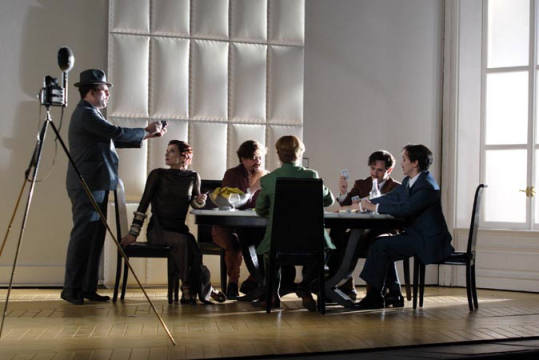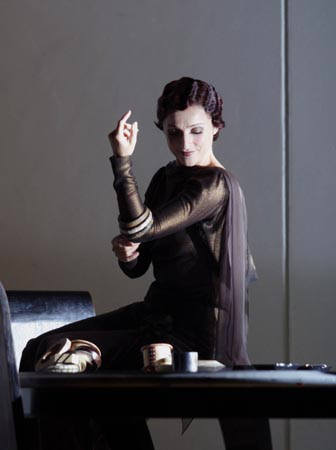Other Links
Editorial Board
- Editor - Bill Kenny
Founder - Len Mullenger
Google Site Search
SEEN
AND HEARD OPERA REVIEW
Handel,
Partenope:
Soloists and Orchestra of English National Opera/Christian Curnyn.
9.10.2008 (CC)
English National Opera certainly seems to have an affinity for
Handel. In 2003, they put on
Semele with a cast
that included Carolyn Sampson and Ian Bostridge (and Patricia
Bardon, the only singer common to both productions). It was a
splendid production, but I had some doubts as to the evenness of
invention of Handel’s music. No such caveats here (the run time of 3
hours 45 minutes flashed by)
Rosemary Joshua’s stamina, her vocal accuracy and her musical acuity
would probably be enough to carry the show single-handedly. She
looks the part too, slim and sophisticated. Her vocal agility never
flagged (“Both Destiny and Love shall battle in my name” from Act 1
being a high point). Countertenor Iestyn Davies was Armindo, his
voice bright and clear, his pitching always seeming to find the
middle of the note, and his acting convincing (he did seem
positively distraught in “How I long to explain my sighing”).
Cast:
Partenope Rosemary Joshua
Rosmira Patricia
Bardon
Arsace Christine Rice
Armindo lestyn Davies
Emilio John Mark Ainsley
Ormonte James Gower

The text for Handel’s piece was anonymously adapted from a libretto
by Silvio Stampiglia; we heard it in the English translation by the
ever-excellent, ever-witty Amanda Holden. Director Christopher Alden
sets this Partenope in a twenties Parisian salon. I am one of
those with no objections to (intelligent) resetting of operas, and
the elements of farce, the quick-fire movements of partners (with
everyone ending up with the
“right” one),
not to mention the plethora of cross-dressings seem to suit the
quixotic, quicksilver nature of the 1920’s as we perceive it now.
Surrealism plays a huge part in the staging, most obviously in the
casting of Emilio (sung by John Mark Ainsley) as the photographer
Man Ray, who seeks to record, to manipulate and to transform all
around him while remaining a character in the opera itself. Actual
pictures by Man Ray inspired much of the more oblique moments we
were treated to. Lighting, by Adam Silverman, was amazingly
inventive and clean, reflecting the generally minimalist aura of the
staging. There is plenty of “cleverness” all around. Background hiss
is introduced for an aria, “This music with sorrow surrounds me”
from Act III, which is accompanied
(ostensibly) by a gramophone.
Partenope herself is portrayed as omnipotent, and we the audience,
are the privileged observers of her inner circle. Nothing here, as
the ENO blurb attests, is what it seems. Disguise is rife (almost
right away, we see the character of Rosmira dressed as a man –
although in spite of this (s)he is recognised by an
Ex, Arsace).
Jealousy is the inevitable by-product of Partenope’s sexual
popularity, resulting in rivalries that lead to a duel.

Rosemary Joshua as Partenope
Mezzo Patricia Bardon was a proud-of-voice Rosmira (disguised
as Eurimene), overshadowing perhaps a little her Arsace, Christine
Rice, who could come across as somewhat weak vocally (as well as in
terms of acting, in Act II) while Iestyn
Davies’ Armindo provided plenty of fun. Poor old John Mark Ainsley
as the camera-toting Emilio, negotiated his runs with ease (better
be careful how I phrase things, as he sings an Act
II aria from a toilet!) while being asked
to sing in a variety of improbable situations (including half way up
a ladder dressed in a kilt!) Only in the final stages of the opera
was a certain amount of air around his notes noticeable. By the way,
was the similarity of looks between Emilio and Eric Morecombe
accidental, I wonder? Am I the only one who noticed it?
It was hangovers all round for the opening of Act
III, where the slogan of the opera, and certainly this
staging, is made explicit: “Things are not always what they seem;
Love can be blind.”
Christian Curnyn was making his ENO debut (he conducts the Chandos
recording, but the forces there are the Early Opera Company). The
pit orchestra probably played as tightly
as I have ever heard it,
with rhythms crisp and alive and with high strings articulating at
speed with superb ensemble, yet capable also of the deepest forms of
expression.
Please note
that this performance of Partenope will be broadcast on BBC
Radio 3 on Saturday November 8th at 630pm. Do hear it.
This piece is rarely done (this run is the first London staging
since the 1982/83 London Handel Festival) and deserves all the
support it gets. Superb.
Pictures © Catherine Ashmore
Back
to Top
Cumulative Index Page
